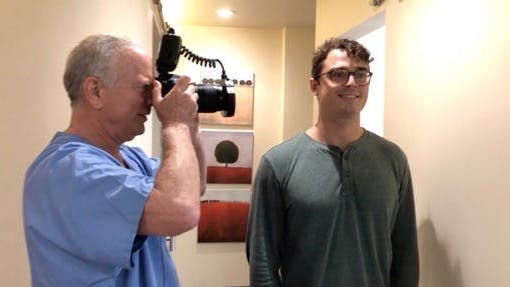Using digital photography to skyrocket treatment acceptance
Treatment acceptance is critical to the health of your patients and to your practice. So often, despite the obvious problems we see in our exams, patients have no idea what is really going on in their own mouths and they don’t want to just take our word on the subject. If nothing is bothering them, they have no perception of a problem and they don’t feel the need to do anything. Even if they do have an idea that something is wrong, they often don’t realize the extent. So, what can we as dentists do to enlighten patients and motivate them to get the help they need?
Images on a flat screen make an impact
We have a number of technologies available to us today to educate our patients. Digital x-rays, CBCTs, digital scanners, intraoral cameras, and digital SLR cameras are a few of them. Of these, our favorite is the DSLR paired with a big flat screen at chairside. The other technologies mentioned are more advanced to be sure, but it never fails to surprise us how impressed patients are to see their teeth magnified and in living color on a big flat screen TV. Virtually all of our patients—including patients who are dentists—have never seen their teeth in such detail.
Recommended clinical photos
As we’ve said in previous articles, in presenting treatment to patients, it is prudent to have a true informed consent discussion, including all treatment options, and bear in mind the words of William J. Mayo, MD: “The best interest of the patient is the only interest to be considered.” With that said, these are the photos we recommend taking with your DSLR—and it only takes a minute or two to shoot them. We use a Canon 60D with a ring flash and a macro lens, purchased from Norman Camera, but there are many outstanding newer options.
- Smiling portrait
- Relaxed portrait
- Profile
- Profile smile close-up
- Straight-on smile close-up
- Right lateral smile close-up
- Left lateral smile close-up
- Retracted bite
- Retracted slightly open
- Right side bite
- Left side bite
- Upper right quadrant with articulating paper and CO bite
- Lower right quadrant with articulating paper and CO bite
- Upper left quadrant with articulating paper and CO bite
- Lower left quadrant with articulating paper and CO bite
- Full upper arch
- Full lower arch
Immediately after taking these 17 clinical photos, we simply plug the camera directly into the flat screen and show the photos, prefaced by saying “We’re going to scroll through your photos first to get an overview, then we’ll look more closely at a few of them, but please feel free to ask any questions as we go, okay?” When patients see their teeth in the same way that we see them, patients inevitably ask questions and make comments about failing fillings, fractured/worn teeth, gum recession, crowding/bite problems, missing teeth, and cosmetic issues. When they ask questions and make comments, it is your golden opportunity to have an informed consent discussion about all their treatment options along with the risks, benefits, and alternatives of each.
Increased credibility = increased case acceptance
The bottom line is that clinical photos shown on a big flat screen lend credibility to your treatment recommendations and help patients understand their problems so they can make informed decisions with your guidance about what to do—in their best interest. This, in turn, will increase your treatment acceptance and help your patients achieve their best possible health.
Author's note: For more information on clinical photography and treatment presentation, visit Dental Suite 903.
Editor's note: This article originally appeared in DE Weekend, the newsletter that will elevate your Sunday mornings with practical and innovative practice management and clinical content from experts across the field. Subscribe here.
Josh Bernstein, DDS, is a clinical instructor in cosmetic dentistry, full-mouth reconstruction, and IV sedation, as well as a conscious sedation evaluator for the Dental Board of California. He lectures nationwide and is published nationally and internationally. He and his wife, Allison Bernstein, have a private, fee-for-service, out-of-network practice in Oakland, California, focusing on cosmetic dentistry, sedation dentistry, and Invisalign. Visit dentalsuite903.com for more info.
Allison Bernstein, is a practice management professional with expertise in teaching patient communications to assist dentists and their teams on becoming less dependent on insurance. She and her husband, Josh Bernstein, DDS, host a podcast called Dental Suite 903 and have a Master Class by the same name. They have a private, fee-for-service, out-of-network practice in Oakland, California, focusing on cosmetic dentistry, sedation dentistry, and Invisalign. Visit dentalsuite903.com for more info.
About the Author

Josh Bernstein, DDS
Josh Bernstein, DDS, is a clinical instructor in cosmetic dentistry, full-mouth reconstruction, and IV sedation, as well as a conscious sedation evaluator for the Dental Board of California. He lectures nationwide and is published nationally and internationally. He and his wife, Allison Bernstein, have a private, fee-for-service, out-of-network practice in Oakland, California, focusing on cosmetic dentistry, sedation dentistry, and Invisalign. Visit thriveoutofnetwork.com for more info.

Allison Bernstein
Allison Bernstein, is a practice management professional with expertise in teaching patient communications to assist dentists and their teams on becoming less dependent on insurance. She and her husband, Josh Bernstein, DDS, host a podcast called Dental Suite 903 and have a Master Class by the same name. They have a private, fee-for-service, out-of-network practice in Oakland, California, focusing on cosmetic dentistry, sedation dentistry, and Invisalign. Visit thriveoutofnetwork.com for more info.


